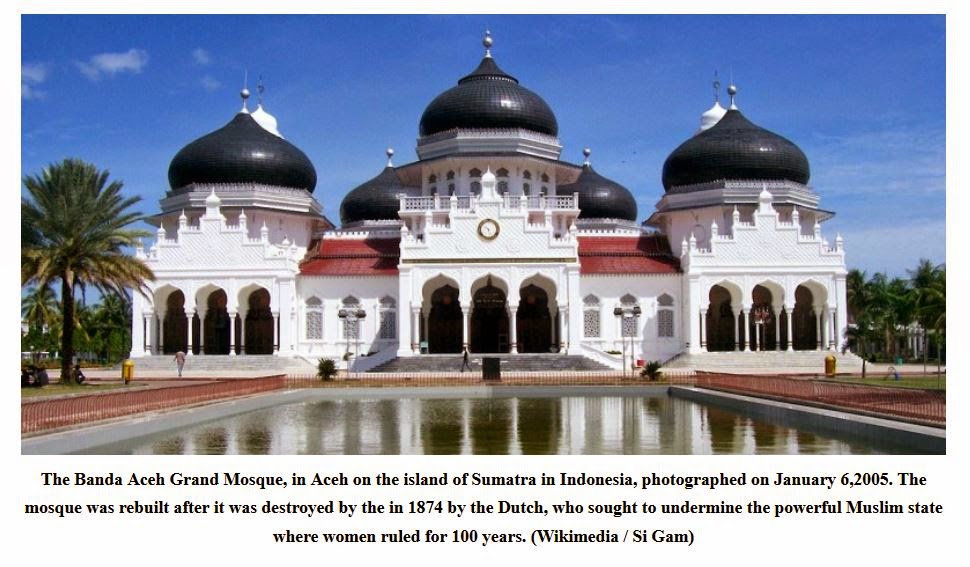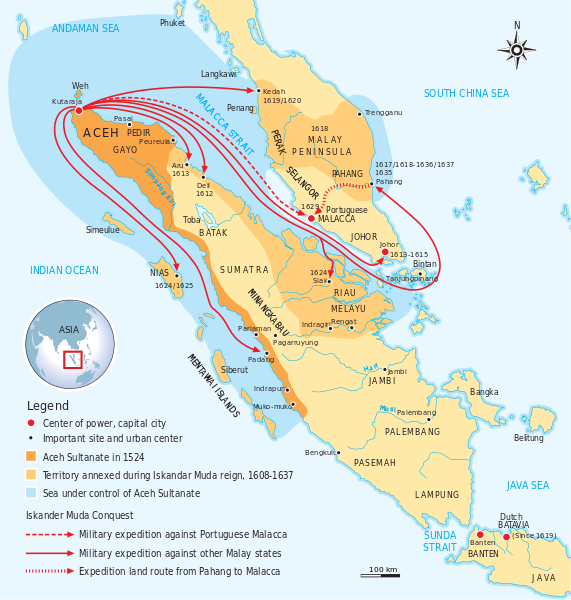Four Women Who Ruled In Indonesia – Our Article published on MintPress
Dear Readers,
happy to show you our article published on MintPress today about the female rulers in Aceh, in today’s Indonesia.
Thank you for reading and sharing
Dr. phil. Milena Rampoldi – ProMosaik e.V.

Banda Aceh Grand Mosque, in Aceh on the island of Sumatra in Indonesia,
photographed
destroyed by the in 1874 by the Dutch,
powerful Muslim state where women ruled for 100 years.
Gam)
See also Introduction: A Forgotten Study Of Female Political Power In Islamic History.
The state of Aceh, founded in the northern part of Sumatra in the
early 16th century, was the most powerful Moslem country (especially in
the second half of the 16th and first half of the 17th centuries) in the
Far East until it was taken over by the Dutch in 1873. This state
offered the most stubborn resistance to the Western powers, particularly
Portugal which established a base in Malacca at the beginning of the
16th century.
And like the Maldives
and other Islands, also here there was a strong matriarchal tradition
before the arrival of Islam. However, the role of the female rulers of
Aceh was more passive than it was the case on the Maldives. It was
during this period that the Sultanate of Aceh was founded and then
established by the appointed ruler Ibrahim. It is reported that Ibrahim,
who took the title Ali Mugâyet Shah, was poisoned by his wife, the
daughter of the governor of Dyah, who thus avenged her father’s fate
(1528).

map showing the extent of Aceh’s power during the first part of the
17th century, when it became the dominant power in the region.
(Wikimedia / Gunawan Kartapranata)
Ali Mugayet Shah was succeeded by his son Salahuddin who reigned until 1537.
Salahuddin was succeeded by his brother Alauddin el-Kahhar who ruled until 1568.
Sultan Hüseyin (1568-75), who succeeded Alauddin, managed to reach an
agreement with the Queen of Japara in 1573 and attacked Malacca, but
with no result; another expedition, this time in 1575, also failed.
Nevertheless, Aceh never gave up the struggle against Portuguese
colonialism. In 1582, Alauddin Mansur Shah (1577-1586) sent another
fleet against Malacca, which again had to withdraw having achieved
nothing. Aceh reached the zenith of its power during the reign of
Alauddin Mansur Shah. The country was prosperous, and all the kings of
Asia courted his friendship. No other country in the Subcontinent could
rival it in commerce.
A rebel commander came on the throne with the name of Sultan Alauddin
Riayet Shah (1586-1604) after Mansur Shah. His son Ali Riayet Shah
(1604-7) followed him, but soon showed that he did not deserve his
exalted post; he spent all his time among the women of his harem, and
his complete indifference to administrative problems soon led to
disorder and restlessness in the country.
In 1606, the Portuguese launched an attack on Aceh and even managed
to take the outer fortifications. In this situation, the Sultan’s nephew
fought with such valour that the Portuguese had to withdraw. This won
the prince great fame and sympathy among the people.
His ambitious mother decided to exploit this event and to put her son
on the throne. She began to distribute gifts and money among the emirs
and the populace to win their support. By a lucky-for them coincidence,
the Sultan died suddenly; the young prince at once took over the palace
arid with the help of the guards, officers and the palace chamberlain
(to all of whom he had made all kinds of promises) was enthroned as
Iskander Muda (1607-1636).
The Sultan of Pedir had been informed of the death of his brother,
but was not aware of what had transpired later. He came to Aceh and
entered the palace without any precautions, Iskander Muda Shah had him
arrested and, a month later, executed.
All the persons and the chamberlain who had helped the new Sultan to
the throne soon met with the same fate. Muda Shah proved himself,
contrary to all expectations, an extremely cruel tyrant. After friendly
overtures to the Dutch and the British and the granting of the privilege
of opening trading posts in Aceh, he reversed himself and closed these
ports.
In 1613, Iskander Muda invaded Aru and Siyak, and later Johor. In
1615, he organised a vast expeditionary force to capture Malacca, in
which enterprise he was unsuccessful, but, in 1618, he managed to take
Queda on the Malaccan peninsula and Delhi in Sumatra. Another attempt on
Malacca in 1622 was unsuccessful because of the reinforcements received
by the Portuguese at the last moment.
After Iskander Muda’s death in 1636, his close relative and
son-in-law succeeded to the throne as Iskander II. This Sultan achieved
what had eluded all his predecessors: he took Malacca and put the
Malacca Straits completely under Aceh control. This marks the second
golden age of Aceh history.
When Iskender II died in 1641, he left no male successor to the
throne. His wife (and Iskander Muda’s daughter) succeeded to the throne
without meeting any objection as Safiyetuddin Taj ül-Alem (1641-1675);
thus began a period of 58 years of women’s rule, when Aceh had four
woman sovereigns one after the other in succession until 1699. This even
led to the mistaken belief among English residents there in 1688 that
Aceh had always been ruled by woman sovereigns, even if it was not the
case from the beginning of its history, but only during the 17th
century.
But as we said in the introduction to this article, the female power
was in reality passive and controlled by an oligarchy of emirs.
Safiyetuddin Taj ül-Âlem reigned for 34 years, until 1675. Upon her
death, the emirs chose Nakıyetüddîn Nur Âlem as queen. We notice that
gradually a tradition was established in Aceh whereby an unmarried
elderly lady unconnected with the old royal line was appointed queen.
Queens were virtual prisoners in the palace after their election.
Though never seen by the lower classes, she went once a year dressed in
white and riding an elephant to bathe in the Aceh river. She also
received foreign ambassadors and missions.
When Nakıyetüddîn Nur Âlem died in 1678, the emirs chose Zekiyetüddîn
Inayet Shah as queen (1678-88). She is known for having refused to give
the British mission the permission to build a fort in Aceh territory.
All that the British mission could obtain was the permission to build a
trading post of wood, and the promise that their traders would be
treated well.
After Zekiyetüddîn Inayet Shah’s death, Zıynetüddîn Kemâlât Shah was
put on the throne (1688-1699), but four emirs who wanted a king rather
than a queen rose in arms and marched against the capital. Sporadic
fighting went on between them and the forces which had remained loyal to
the queen and which were on the west bank of the river. After that,
during her reign, the opponents of woman sovereigns ruling Aceh obtained
an edict from Mecca to the effect that a woman could not be the ruler
of a state, and upon her death in 1699, prevented the election of
another woman as queen. As we can remember, the same happened to Shejer ad-Durr in Egypt who had to abdicate because of the Caliph’s edict.
However, after this century of female rulers, the internal struggles
on the one hand, and the increasing pressure of imperialistic powers to
penetrate and conquer these regions on the other hand, had reduced the
state of Aceh to a mere shadow of its former powerful self. Finally, in
1873, the Dutch invaded Aceh and put an end to this powerful Muslim
nation.
This entry is based on “Female Sovereigns in Islamic States.” You can find it on Amazon here.


